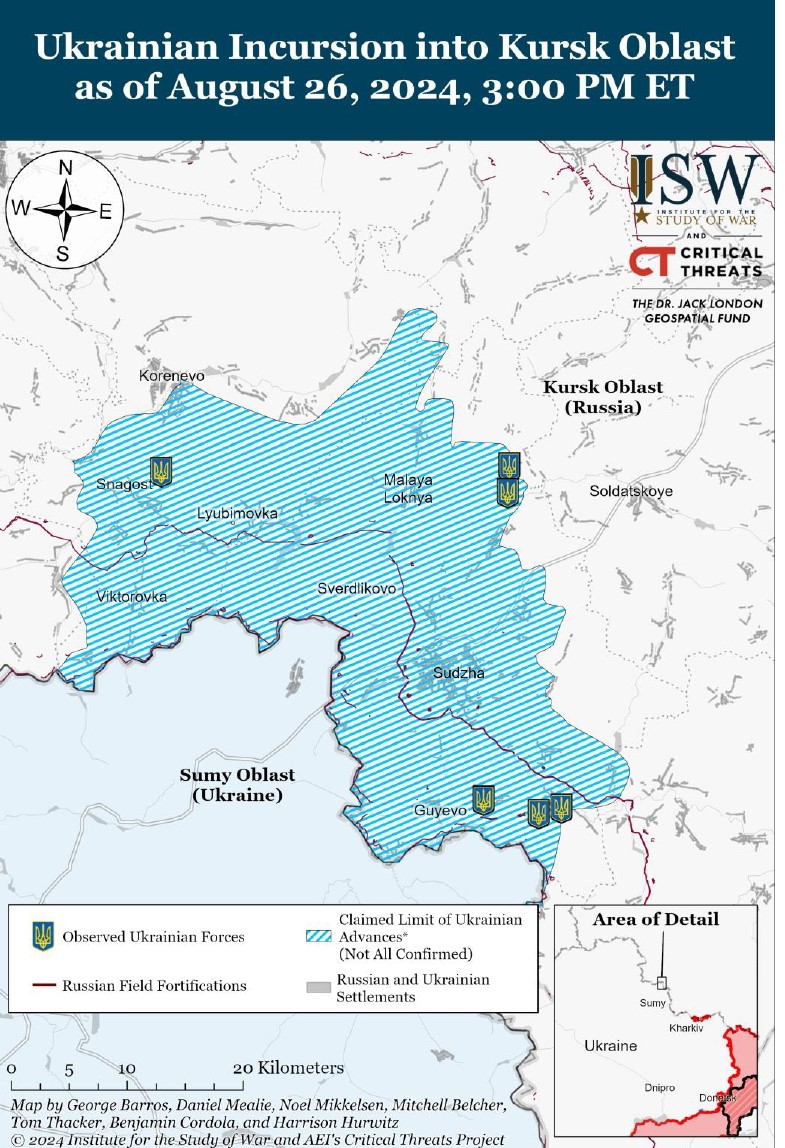Ukraine War Update: Surprising Ukraine Incursion in Russia Continues
Bottom Line: Ukraine’s surprise cross-border offensive inside Russia's western Kursk region continues with pace as Ukrainians recently advanced near Sudzha. In response, Russian military deploys forces from lower priority sectors of the frontline in Ukraine to the frontline in Kursk Oblast. We foresee it is still unlikely that Russia will allow Ukrainian forces to go too far, but deploying more men and material to Kursk region will take time and will be slower than expected. As we envisaged, Russia already started stronger missiles and drone attacks into Ukraine territory, as it conducted one of the largest combined series of drone and missile strikes against Ukrainian critical infrastructure to date on August 26 while the use of any tactical nuclear weapons remains unlikely for now. It will likely be hard for Ukraine to sustain the operation whilst Russia continues to bring more artillery and aviation, and it is uncertain whether the operation will be a game changer. The incursion is expected to increase Ukraine’s bargaining position at any negotiations in the future and will likely work as a hedge should Trump is reelected as U.S. president, splits western support and leading to a probable Russia-friendly peace deal, likely in 2025.
Figure 1: The Military Situation in Kursk Oblast, August 26

Source: Institute for the Study of War (ISW)
Ukraine’s Surprise Attack into Russia Continues
After Russia executed strong counteroffensive operations in Ukraine this summer, and recently advanced northeast of Kharkiv City, north of Chasiv Yar, southeast of Pokrovsk, and west of Donetsk City aiming to seize more territory before the U.S. presidential elections in November, Ukraine’s cross-border offensive inside Russia, which started on August 6, surprised Russians tactically. According to sources, Ukrainian forces recently advanced near Sudzha, and have taken almost as much territory in Russia in August (some 1,200 square kilometers by their own estimates) as the Russians have won inside Ukraine all year. Ukrainian officials continue to highlight how Ukrainian forces can leverage tactical and technological advantages to offset Russian materiel advantages as they aim to demonstrate that Russian victory is not inevitable.
In response, the Russian military reportedly continues to deploy forces from lower priority sectors of the frontline in Ukraine to the frontline in Kursk Oblast as the operation pushed Russia to draw some of its forces, and forced Russia to the defensive positions. As we envisaged, Russia already started stronger missile and drone attacks into Ukraine territory, as it conducted one of the largest combined series of drone and missile strikes against Ukrainian critical infrastructure to date on August 26 while the use of any tactical nuclear weapons remains unlikely for now.
Speaking about the cross-border offensive, President Zelensky stated last week that Ukraine’s incursion aims to create a buffer zone to prevent cross-border attacks by Moscow’s forces. “Everything that inflicts losses on the Russian army, Russian state, their military-industrial complex, and their economy helps prevent the war from expanding and brings us closer to a just end to this aggression,” Zelensky added.
On Russia front, President Putin underscored that any peace talks are impossible following attacks in Kursk Region. Putin refuted allegations about contacts ahead of potential Qatar-and Turkey-mediated talks with Kiev, slamming them as mere rumors.
We think it will be hard for Ukraine to sustain the operation whilst Russia continues to bring more artillery and aviation, and it is unclear whether the operation will be a game changer. The cross-border operation has demonstrated that Russia’s border defenses are weak to respond to further Ukrainian cross-border incursions could impose long-term operational planning costs and constraints that Russia previously did not face before.
The incursion is expected to increase Ukraine’s bargaining position at any negotiations in the future. According to the political analysts, the operation will likely work as a hedge should former President Trump win the US election and seek to force a peace settlement on Ukraine.
We continue to think the U.S. presidential elections would finally set the scene in Ukraine, and we envisage the former U.S. President Trump will likely not provide firm backing for Ukraine, if elected. President Putin continues to wait for the possibility of a Trump win and splits western support and leading to a Russia friendly peace deal with current territories, but the impacts of the incursion could moderately change the game, likely less land to Russia in 4 occupied regions. The key will be how the incursion goes, and how fast and strong Russia responds back.